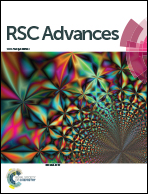A facile low temperature route to deposit a TiO2 scattering layer for efficient dye-sensitized solar cells†
Abstract
Herein, we demonstrate a facile low temperature chemical bath deposition approach to deposit a light scattering layer on a nanostructured mesoporous TiO2 bottom layer in a dye-sensitized solar cell architecture. Large TiO2 nanoparticles were formed on the top surface of photoanode electrodes via hydrolysis of TiCl4 at 70 °C. We controlled the size and agglomeration of these TiO2 nanoparticles by altering the concentration of TiCl4 in the chemical bath during the hydrolysis process. Electron microscope images revealed that mono-dispersed scattering particles having uneven surfaces with diameters between 100 to 300 nm formed on the mesoporous titania layer. The scattering behavior of the formed titania overlayer was confirmed by the improved reflectance in the diffuse reflectance spectrum of the films. We also observed a significant improvement in the density of states near the band-edge of titania for the TiCl4 treated electrodes as well as a considerable decline in the sub-band gap absorption states. Consequentially, enhancement in the photovoltaic parameters of TiCl4 treated based solar cells is achieved which led to a power conversion efficiency of 8.54% for the cell having an optimum content of large titania particles on the top surface compared to 7.10% for the pristine titania based solar cell.


 Please wait while we load your content...
Please wait while we load your content...